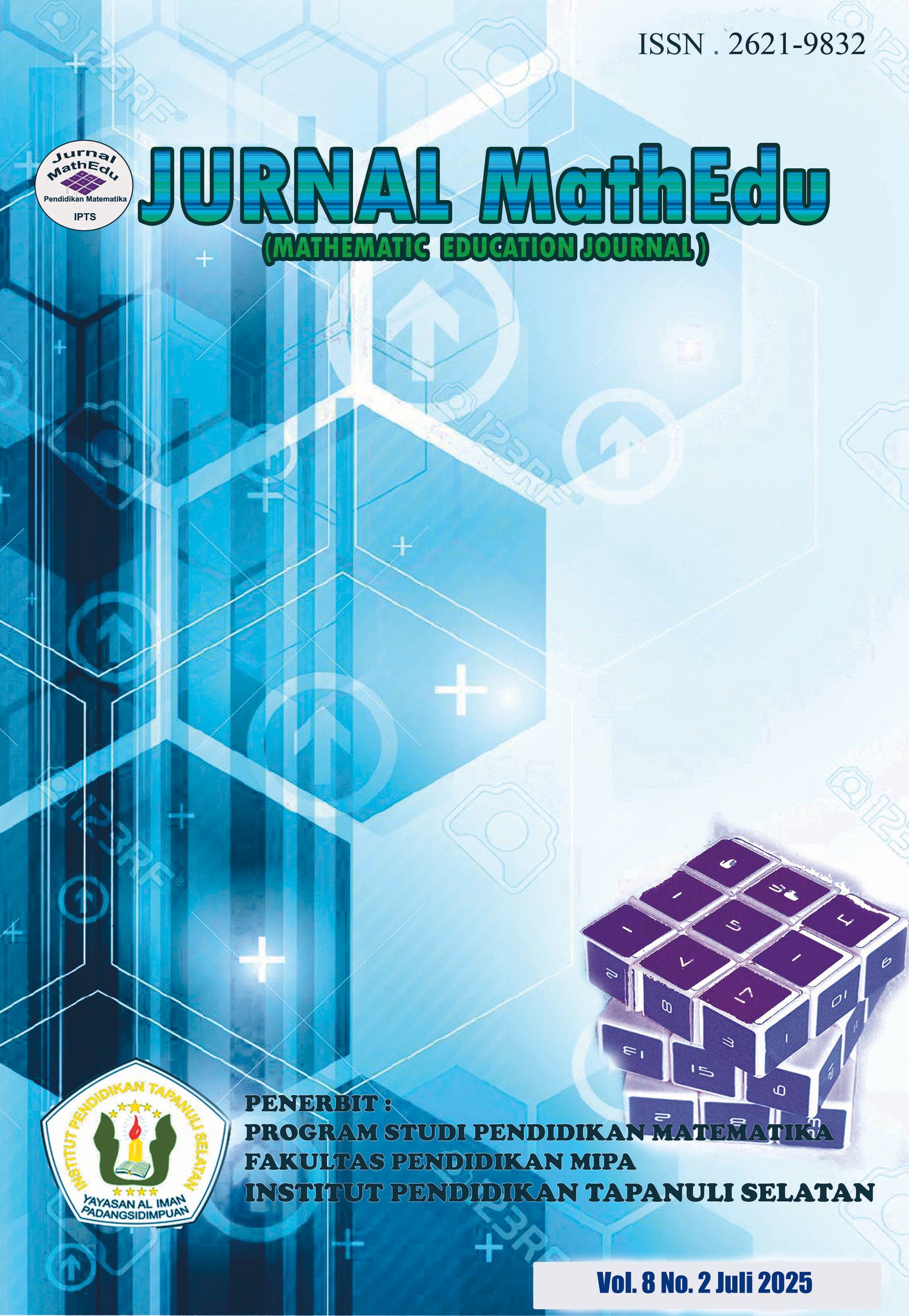Systematic Literature Review: Commognitive dan Kemampuan Komunikasi Matematis
Main Article Content
Abstract
This study aims to analyze the relationship between commognitive theory and students’ mathematical communication skills at the secondary education level, specifically in junior and senior high schools. This review is motivated by the importance of understanding students' thinking processes in expressing mathematical ideas verbally, visually, symbolically, and procedurally. Commognitive theory, which comprises four main components word use, visual mediators, narratives, and routines provides a conceptual framework for examining the dynamics of students’ mathematical discourse. The method employed is a Systematic Literature Review (SLR) following the PRISMA protocol. A total of 26 articles were analyzed, sourced from the Scopus and Google Scholar databases, with inclusion criteria covering publications from 2013 to 2024 relevant to the topic and the context of secondary school students. The findings were categorized into three major themes: (1) the application of commognitive theory in mathematics instruction at the secondary level; (2) indicators of students’ mathematical communication in written, oral, and visual forms; and (3) the interrelation between commognitive components and dimensions of mathematical communication. The review reveals that students exhibit varying tendencies in activating commognitive components depending on the type of task and the mode of problem presentation. Nevertheless, the explicit integration of commognitive theory and mathematical communication indicators has not yet been thoroughly explored. The implications of this review highlight the urgency of developing discourse-based assessment instruments, as well as designing challenging tasks that foster student engagement across all aspects of mathematical thinking and communication.
Article Details
Authors who publish with this journal retain copyright to their articles. However, they grant the journal the right of first publication with the work simultaneously licensed under a Creative Commons Attribution License that allows others to share the work with an acknowledgment of the work's authorship and initial publication in this journal.
References
Ioannou, M. (2012). Analyzing university students’ mathematical discourse: A commognitive perspective. International Journal of Mathematical Education in Science and Technology, 43, 591–609.
Karavi, A., & Harel, G. (2022). Commognitive analyses of university students’ argumentation in proof construction. Journal of Mathematical Behavior, 65, 100934.
Kilpatrick, J., Swafford, J., & Findell, B. (2001). Adding it up: Helping children learn mathematics. National Academy Press.
Kontorovich, I. (2021). A commognitive analysis of university students’ proof practices. International Journal of Research in Undergraduate Mathematics Education, 7, 234–255.
Lavie, I., Steiner, S., & Sfard, A. (2019). Routines we live by: From ritual to exploration. Educational Studies in Mathematics, 101, 153–176.
Leong, Y. H., et al. (2020). Understanding mathematical discourse in classrooms: Commognitive analysis of teacher-student interactions. International Journal of Science and Mathematics Education, 18, 123–142.
Lu, L., et al. (2022). Commognitive responsibility shifts in collaborative problem solving. ZDM Mathematics Education, 54, 899–913.
Moher, D., et al. (2009). Preferred reporting items for systematic reviews and meta-analyses: The PRISMA statement. PLoS Medicine, 6, e1000097.
Morgan, C. (2014). Improving the quality of mathematics teaching through effective lesson design. Routledge.
Morgan, C. (2020). Language and assessment in mathematics education. Mathematics Education Research Journal, 32, 275–292.
NCTM. (2000). Principles and standards for school mathematics. National Council of Teachers of Mathematics.
Nathanson, R., et al. (2024). Mathematical discourse and reasoning: A commognitive perspective. Mathematics Teaching Research Journal, 16(1), 1–18.
OECD. (2019). PISA 2018 Assessment and Analytical Framework. OECD Publishing.
Presmeg, N. (2006). Research on visualization in learning and teaching mathematics. In Handbook of Research on the Psychology of Mathematics Education (pp. 205–235).
Presmeg, N. (2016). The role of semiotics and commognition in mathematics education research. Educational Studies in Mathematics, 91, 247–265.
Radford, L. (2014). Arithmetical algebraic thinking, the didactic transposition, and the elaboration of meanings. Journal of Mathematical Behavior, 33, 44–62.
Sfard, A. (2007). When the rules of discourse change, but nobody tells you: Making sense of mathematics learning from a commognitive standpoint. Journal of the Learning Sciences, 16, 565–613.
Sfard, A. (2008). Thinking as communicating: Human development, the growth of discourses, and mathematizing. Cambridge University Press.
Siddaway, A. P., Wood, A. M., & Hedges, L. V. (2019). How to do a systematic review: A best practice guide for conducting and reporting narrative reviews, meta-analyses, and meta-syntheses. Annual Review of Psychology, 70, 747–770.
Sumarmo, U. (2010). Karakteristik dan pembelajaran matematika untuk meningkatkan kemampuan berpikir dan disposisi matematis siswa. FMIPA UPI.
Tabach, M., & Rasmussen, C. (2014). Commognitive analysis of mathematical activities in small groups. Educational Studies in Mathematics, 86, 1–21.
Tyskerud, Y., et al. (2022). Teachers’ reflective discourse in mathematics. Teaching and Teacher Education, 108, 103542.
Vygotsky, L. S. (1978). Mind in society: The development of higher psychological processes. Harvard University Press.
Yackel, E., & Cobb, P. (1996). Sociomathematical norms, argumentation, and autonomy in mathematics. Journal for Research in Mathematics Education, 27, 458–477.
Zayyadi, M., et al. (2019). Commognitive analysis of middle school students' thinking in solving geometry problems. Infinity Journal, 8, 45–54.

